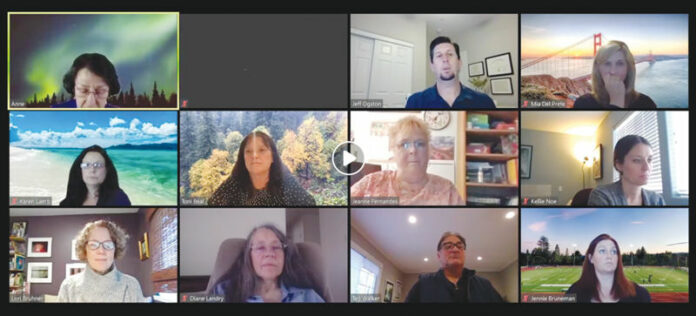
At its April 8 board meeting, the West Sonoma County Union High School District (WSCUHSD) board gave the superintendent permission to make up to approximately $1.5 million in cuts to next year’s school budget, while at the same time approving a raise of 8% over two years for the administrative staff, including the superintendent and the chief budget officer.
The meeting was held via Zoom and broadcast live via Facebook. It was the district’s first experiment with a virtual meeting. Those interested in public comment had been told to submit their questions ahead of time. Few did, however, and no accommodations had made for people asking questions via Facebook.
What’s with all the cuts?
Even with the recent passage of the Measure B parcel tax, which will inject $1.8 million into the district’s coffers, the high school district was staring down the barrel of $400,000 in cuts required to keep its three-year budget in the black.
Now, with the COVID-19 pandemic, schools across the state are preparing to make even more draconian cuts.
At the meeting, Superintendent Toni Beal laid out three budget cut scenarios:
1) The first scenario, which the board has been contemplating for the last several months, involves cuts of $400,000. Most of these cuts, which are necessary to close the district’s budget gap, have been discussed on and off over the last year.
2) The second scenario makes the assumption that because of the COVID-19 pandemic, the Governor’s May budget revision will include no cost-of-living adjustment for schools. This would require an additional cut of $450,000, which added to the $400,000 in the previous scenario comes to $850,000 in cuts for the next school year.
3) The third scenario predicts even less money coming from the state because of tumbling state revenues caused by the pandemic. Sky-rocketing unemployment, decreased consumer spending because of the economic shutdown, a transfer of funds away from education and toward health care, and the possibility that a significant segment of the population may be unable to pay property taxes could significantly decrease the amount of money the state has to spend on education. Anne Baron, the district’s interim CBO, estimated that the district would have to come up with an additional $500,000 to make up the difference. (At the meeting, Baron wondered aloud whether she should have made that a bigger number.) Combined with cuts from the first two scenarios, this means the district would be facing $1.3 million in cuts.
The Superintendent’s Budget Committee has been working for the last year to create a prioritized list of budget cuts that include changing benefits packages, cutting bus routes, deferring textbook purchases and staff reductions that will first affect secretaries, school librarians, counselors and finally teachers. (Find a PDF of this document in this story online.)
Though the committee tried to keep the cuts “away from the classroom,” Board Member Ted Walker said, “These cuts are affecting everyone from the kid in the classroom to the cook in the kitchen.”
An 8% raise for administrators
At the end of the evening, the board gave a 4% raise to the district’s administrative staff for this year and next year — an 8% raise overall. They called it a “me too” increase, meant to match the increase the teachers had won earlier in the year by going on strike.
Response from the teacher’s union was instantaneous.
Analy Spanish teacher and West Sonoma County Teacher’s Association (WSCTA) union president Lily Smedshammer said, “WSCTA is very disappointed in our district tonight. While planning for state budget reductions, layoffs, busing cuts, the trustees approved a “me too” raise of 8% for all admin, including the superintendent who fought us and forced a 3-day strike. The decision happened so quickly, there was no way to comment or oppose, and it was imbedded in confusing updates about board policy.”
“We strike and they get the raise with no loss to work days.” Smedshammer wrote on the district’s Facebook page during the meeting. “That raise will be coming out of the general fund. That money could reinstate staff.”
Analy math teacher Brian Miller, also with WSCTA, was aghast.
“I mean who passes something like Measure B and follows it up with cuts to student services and a raise to the superintendent and other district leadership?” he said.
He found the raise for administrators particularly egregious given that the district is still negotiating a contract with its poorly paid classified staff.
“That management takes raises when our classified members don’t have a deal is absurd,” he wrote. “Even in this time of crisis, this school board continues to seem out-of-touch with the moment, and again unanimously acted in a manner that will lose trust with the community and deepen income inequality in our district.”
Superintendent Toni Beal said the district board was merely confirming the administrative raise that they had already voted in January to approve. (State law requires administrator raises to be discussed publicly.)
She said classified staff had been offered the exact same raise. (Negotiations with classified staff are still ongoing.)
“It has always been the practice in the district to offer the same compensation increases to all employee groups as the board values all of the district employees — teachers, classified, confidential and management.”
After two years, Beal’s salary will be $187,644, an increase of more than $19,000 over her present salary.
Beal seemed disappointed that the administrator raise seems to have raised the ire of the teachers union.
“I know the optics are being criticized out there,” she said. “There was no intention of misleading anyone or sneaking anything through. The Board really wants to make it clear that they value all employees. If the pandemic would not have happened, we would be reducing the budget by $400,000. Now we are in a whole different scenario that will take all of us working together to get through.”








